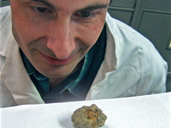Roman Credit Crunch and Medieval Poo

Evidence of the last Roman Credit Crunch?
The British Museum have asked to borrow 44 very rare Roman coins from the Gloucester City Museum & Art Gallery for their national collection in London.
Experts have only just discovered how important and unique some of these coins are after years of study. They are part of a hoard of more than 15,000 silvered coins sealed in a jar, most of which are rare types usually found on the Continent. One of the biggest hoards of Roman coins ever found in Britain, a workman discovered the buried treasure in 1960 at the corner of Eastgate and Westgate Streets about 4m below the modern street level. They were hidden more than 1700 years ago under the floor of what may have been a Roman shop.
The coins could well be evidence of a Roman credit crunch and troubled economic times for Gloucester. At the time these coins were buried, things were so bad in Roman England and the currency was so devalued that standard `silver’ coins were actually base metal with a silver wash to look like solid silver. The finance minister called Allectus had recently murdered his boss and made himself Emperor of a rebel British Empire. The official Roman army had to re-invade Britain to get rid of him. It is thought that the Gloucester treasure was hidden away because these were official Roman coins and therefore more usable than the ones issued by the rebel Allectus.
The jar and some of the coins can be seen on display in the Gloucester City Museum & Art Gallery.
Medieval Poo
People have flocked to see a 1,000 year old poo previously kept hidden in the Gloucester City Museum & Art Gallery.
11,000 visitors saw it when it was loaned to the Gloucestershire County Council’s Archaeology Service for their display in the Discovery Zone of the Cheltenham Science Festival. It proved to be so popular with visitors that it will be shown again at the Tewkesbury Medieval Fair next weekend.
Discovered by archaeologists in 1991 digging on the site of the public car park in Ladybellgate Street, it was found at the bottom of a roadside hole thought to have been dug in Saxon times. With no designated public toilets about 1,000 years ago perhaps a desperate Anglo-Saxon found a hole and thought they would never be found out!! This is an important find because scientists can use it to analyse the diet and heath of our ancestors which helps them to understand similar issues today. Gloucester is well known for remarkable Saxon finds of things that don’t usually survive, including a complete shoe, part of a smart checked dress and human hair.
Planned to be included in the new galleries due to open April 2011 at the Gloucester City Museum & Art Gallery as part of the million pond Heritage Lottery Grant recently awarded to the Gloucester Museum Service.
Explore Gloucestershire
6 July 2010
For further information.
OTHER NEWS
